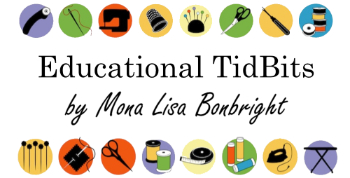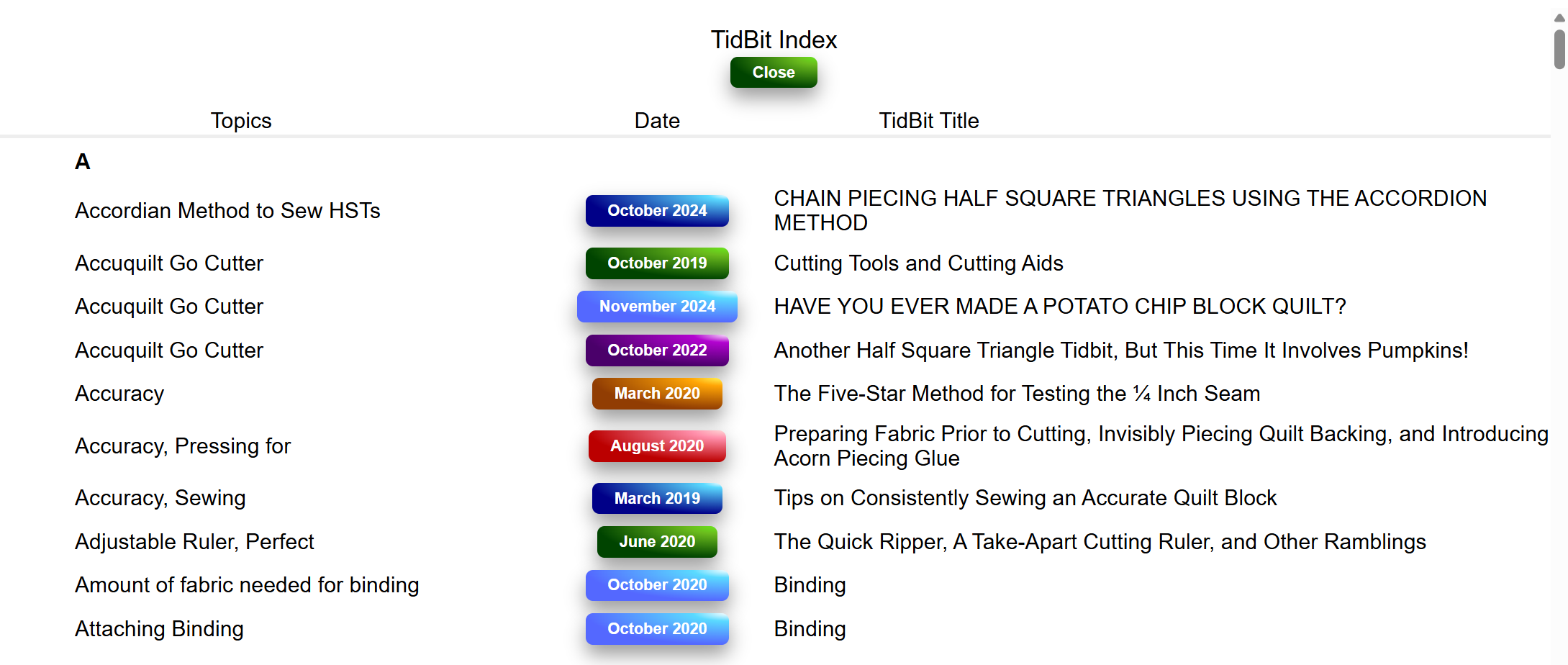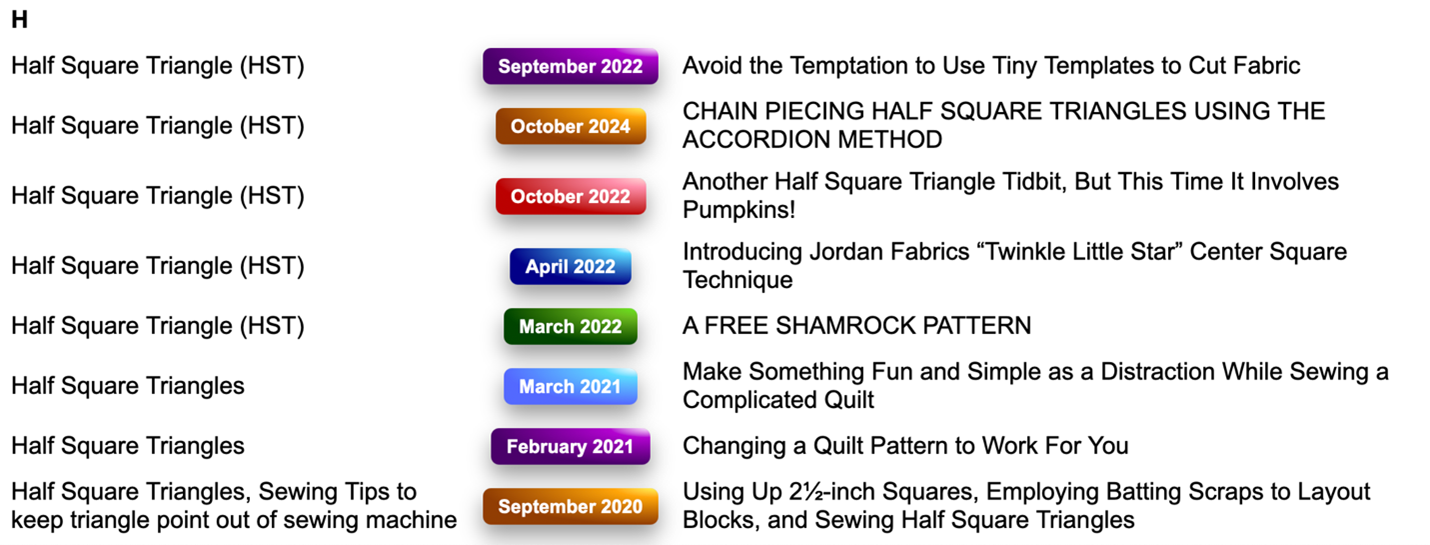

| | Home | Board | Calendar | Education Tidbits | | Members | Newletters | Programs | Philanthropy | Slide Shows | Sign In | |

October 2025
ANNOUNCING THE BRAND SPANKING NEW
INDEX FOR EDUCATIONAL TIDBITS
ON THE CRAZY QUILTERS WEBSITE
ANNOUNCING THE BRAND SPANKING NEW
INDEX FOR EDUCATIONAL TIDBITS
ON THE CRAZY QUILTERS WEBSITE
It is October 2025 already! Where did the majority of 2025 go? We have lots to look forward to in October, including Yom Kippur, Columbus Day or Indigenous People's Day, Boss's Day, United Nations Day, and Halloween. Also, it is the final countdown to Bonanza, the first weekend in November.
But my favorite item this time of year, as I have stated in the past, is plenty of pumpkin pies in stock at Costco. Yum!
Can you believe it, I have been writing and submitting Educational Tidbits since January 2019? Wow, how time flies. I still make plenty of boo boos in my sewing and quilting projects, so I still have lots of potential topics to cover in future tidbits. If you have a topic you would like covered, let me know. I will happily research the topic and give you information I uncover along the way, to see if it covers what you wanted covered. Once it meets your needs, then it gets published as a tidbit.
This month, I am introducing the brand spanking new "TidBit Index" for the Educational Tidbits. Thank you to Ron Nelson, our webmaster, for creating this for me. I simply asked him if it was possible to create an index for the tidbits, and voila, he created it. He is awesome. So... I have attempted to populate the Index based on various topics, products, patterns and other stuff I have included in the tidbits over the years. I have to admit; I need the index myself to see what topics and items I have covered so I don't write the same stuff all over again.
To use the TidBit Index, go to the Crazy Quilters Website and click on the Education Tidbits tab.

Once the Educational TidBits come up, on the left side of the page, look for the blue box, "TidBit Index" and click on it .

You will be taken into the index. Items are listed in alphabetical order from A to Z. Below is an excerpt from the first page.

Scroll down to the topic you are interested in, and the index will list the tidbits that cover that item. Click on the colored date box featuring the month and year, and it takes you right to the tidbit covering the topic. You may have to read through the tidbit to find the info you are looking for. When you are finished looking at the index, click on the green Close box.
Let's try looking at the topic Half Square Triangle:

Before I sign out, I want to take some time to share my favorite Maya Angelou quote:
“I've learned that people will forget what you said, people will forget
what you did, but people will never forget how you made them feel.”
Maya Angelou.
Have a great October. Be good to one another. Share kindness and smiles. Be gracious to those who stumble. Be forgiving to those who blunder. We need each other, our quilty friends and those in our quilting community. We are each precious to one another and to our community.
I hope you enjoy perusing all the tidbit topics using the new TidBit Index. Blessings to you and your family. I have a topic for the November tidbit, but I need one for December. Please let me know if you have a topic I can research and publish for December 2025. Ta Ta for Now (TTFN).

Please e-mail the Webmaster for any problems with the website or any questions: webmaster@crazyquiltersguild.org
 |
October 2025
ANNOUNCING THE BRAND SPANKING NEW
INDEX FOR EDUCATIONAL TIDBITS
ON THE CRAZY QUILTERS WEBSITE
ANNOUNCING THE BRAND SPANKING NEW
INDEX FOR EDUCATIONAL TIDBITS
ON THE CRAZY QUILTERS WEBSITE
It is October 2025 already! Where did the majority of 2025 go? We have lots to look forward to in October, including Yom Kippur, Columbus Day or Indigenous People's Day, Boss's Day, United Nations Day, and Halloween. Also, it is the final countdown to Bonanza, the first weekend in November.
But my favorite item this time of year, as I have stated in the past, is plenty of pumpkin pies in stock at Costco. Yum!
Can you believe it, I have been writing and submitting Educational Tidbits since January 2019? Wow, how time flies. I still make plenty of boo boos in my sewing and quilting projects, so I still have lots of potential topics to cover in future tidbits. If you have a topic you would like covered, let me know. I will happily research the topic and give you information I uncover along the way, to see if it covers what you wanted covered. Once it meets your needs, then it gets published as a tidbit.
This month, I am introducing the brand spanking new "TidBit Index" for the Educational Tidbits. Thank you to Ron Nelson, our webmaster, for creating this for me. I simply asked him if it was possible to create an index for the tidbits, and voila, he created it. He is awesome. So... I have attempted to populate the Index based on various topics, products, patterns and other stuff I have included in the tidbits over the years. I have to admit; I need the index myself to see what topics and items I have covered so I don't write the same stuff all over again.
To use the TidBit Index, go to the Crazy Quilters Website and click on the Education Tidbits tab.

Once the Educational TidBits come up, on the left side of the page, look for the blue box, "TidBit Index" and click on it .

You will be taken into the index. Items are listed in alphabetical order from A to Z. Below is an excerpt from the first page.

Scroll down to the topic you are interested in, and the index will list the tidbits that cover that item. Click on the colored date box featuring the month and year, and it takes you right to the tidbit covering the topic. You may have to read through the tidbit to find the info you are looking for. When you are finished looking at the index, click on the green Close box.
Let's try looking at the topic Half Square Triangle:

Before I sign out, I want to take some time to share my favorite Maya Angelou quote:
“I've learned that people will forget what you said, people will forget
what you did, but people will never forget how you made them feel.”
Maya Angelou.
Have a great October. Be good to one another. Share kindness and smiles. Be gracious to those who stumble. Be forgiving to those who blunder. We need each other, our quilty friends and those in our quilting community. We are each precious to one another and to our community.
I hope you enjoy perusing all the tidbit topics using the new TidBit Index. Blessings to you and your family. I have a topic for the November tidbit, but I need one for December. Please let me know if you have a topic I can research and publish for December 2025. Ta Ta for Now (TTFN).